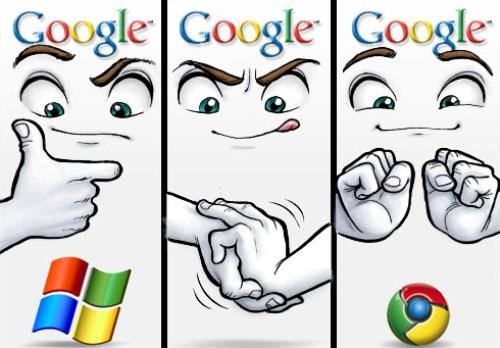April 1, 2015
Over the past decade, Google has evolved from a simple search engine into a serious threat to Microsoft 's future. Google marginalized Microsoft in the mobile market, converted individual users and SMBs from Office to Google Drive, and chipped away at Windows' dominant share of the PC market with cheap Chromebooks.

April 1, 2015
Over the past decade, Google has evolved from a simple search engine into a serious threat to Microsoft 's future. Google marginalized Microsoft in the mobile market, converted individual users and SMBs from Office to Google Drive, and chipped away at Windows' dominant share of the PC market with cheap Chromebooks.

Google relied on a simple strategy: Give away software that Microsoft charges for, then tether those users to its sprawling ecosystem to generate search, advertising, and app revenues. Microsoft couldn't retaliate with a reciprocal strategy, since its top line depended heavily on Windows and Office licenses.
However, Satya Nadella, who replaced Steve Ballmer as Microsoft's CEO last year, has prepared a grand plan to fight back on all fronts. Let's take a look at three of Microsoft's new strategies under Nadella and how they could disrupt Google's long-term plans.
1. One Windows to rule them all
Microsoft respectively controls just 3% and 7% of the smartphone and tablet markets worldwide, according to IDC. However, over 90% of PCs worldwide still run on Windows, according to Net Market Share. Apple 's Macs account for another 7%, while "other" devices, including Linux devices and Chromebooks, account for the remaining 3%.
Therefore, Microsoft will expand its PC ecosystem to include smartphones and tablets with Windows 10, which will be offered as a free upgrade for non-enterprise Windows users on phones, tablets, and PCs. This effort could reduce Windows fragmentation, bring all users back into the same ecosystem, and make Windows Phones and tablets more appealing to PC users with cross-platform apps and synchronization.
Developing apps for Windows Phones and tablets will also become more rewarding for developers, since apps will also reach PC and Xbox One users through "universal apps" at the unified Windows Store. This could resolve the "app gap" between the Windows Store, which has around 500,000 apps, and the Google Play store, which hosts over 1.4 million.
Google is responding to Microsoft's promises of unifying the PC and mobile markets by porting Android apps to Chrome OS, but that impact could be limited by Chromebook's slim market share.
2. User growth at any cost
Microsoft recently eliminated Windows license fees for phones and small tablets, and reduced the fee for laptop OEMs to help them compete against Chromebooks. It bundled free trials of Office 365 and OneDrive with those devices to widen its defensive moat against Google Drive.
Microsoft also recently extended its free Windows 10 upgrade offer to pirates, although the upgraded copies would still be identified as "non-genuine". Microsoft is also undercutting the cheapest Android One devices with low-end Windows Phones like the $70 Lumia 430.
Those tactics indicate that Microsoft is prioritizing user and ecosystem growth over near-term profit, but they could weigh down its bottom line. Last quarter, Windows OEM Pro and non-Pro revenue fell 13% year over year as companywide earnings slipped 9%.
Microsoft is also locking competing operating systems out of PCs and phones. With Windows 10, Microsoft will make its UEFI Secure Boot's "off switch" optional instead of mandatory. This means OEMs can disable a user's ability to install a second OS, such as Linux, by locking the bootloader. On phones, Microsoft is collaborating with Xiaomi to test a ROM that lets users install Windows Phone on Android devices.
3. Forging alliances with Google's enemies and frenemies
In addition to loosening Android's grip on the smartphone market, Microsoft is forging surprising alliances with Android-based companies.
Samsung is the top Android smartphone maker in the world, but it is trying to develop a non-Google ecosystem on its own, which already includes an Android app store, an NFC payments system, and its own OS, Tizen. To distance itself from Google, Samsung agreed to bundle Microsoft's cloud and office apps to its latest Galaxy devices. Microsoft did the same with 11 other Android OEMs, which could divert more Android users away from Google Drive.
Microsoft might have invested an undisclosed amount in Cyanogen, which develops the popular Android-based OS CyanogenMod, according to The Wall Street Journal.. Blu , one of Latin America's top smartphone makers, recently declared that its upcoming CyanogenMod devices would replace Google Maps with Nokia 's HERE Maps, Google Drive with OneDrive, Google Search with Bing, and Google Play with Amazon's AppStore.
Stripping out Google services in that manner is known as "forking" Android. According to ABI Research, 29% of Android devices shipped worldwide in the fourth quarter of 2014 were forked, which represents a big blind spot for Google and a lucrative opportunity for Microsoft.
The bottom line
Microsoft's upcoming Windows 10 blitz will be a fierce one that could cripple Google's advantage of free software and services. If more Android OEMs assist Microsoft, Android fragmentation could worsen, and Google could have trouble monetizing the OS.
But the future is also full of risks for Microsoft. If the company can't replace lost Windows license revenue through ecosystem growth in a timely manner, its bottom-line growth will continue to suffer.
Courtesy: Mortley Fool – The article originally appeared on Fool.com.















































































































